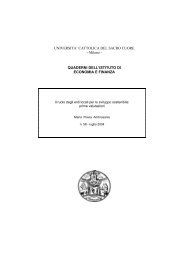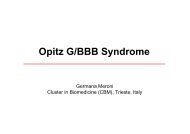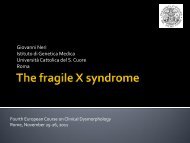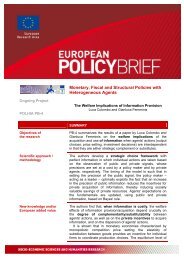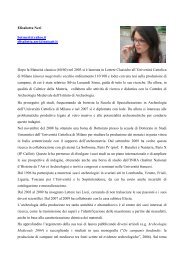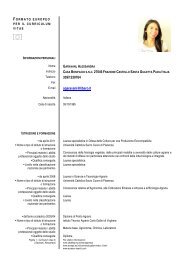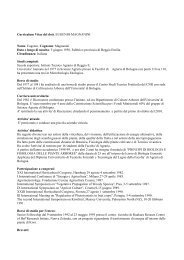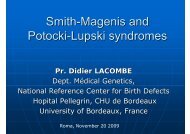UNIVERSITA' CATTOLICA DEL SACRO CUORE - Milano - Istituti
UNIVERSITA' CATTOLICA DEL SACRO CUORE - Milano - Istituti
UNIVERSITA' CATTOLICA DEL SACRO CUORE - Milano - Istituti
You also want an ePaper? Increase the reach of your titles
YUMPU automatically turns print PDFs into web optimized ePapers that Google loves.
2. THE ITALIAN MARKET FOR FIXED TLC<br />
The Italian case constitutes an example of late liberalization: indeed, it took five<br />
years to implement the European Directive n. 90/388/Cee (Competition in Tlc<br />
services market) with D.lgs. n. 103/1995. Two years later, D.p.r. n. 318/1997 4<br />
implemented six European Directives on electronic communications 5 . Legge 31<br />
luglio 1997, n.249 provided economic agents with he necessary legal certainty<br />
and guarantee of political independence by establishing the Autorità per le<br />
garanzie nelle comunicazioni 6 , which became fully operative in the second half of<br />
1998.<br />
Under this settings, it is clear that any valuation of the Italian market has to be<br />
carefully carried out and that it is hardly impossible to discern clear cut<br />
conclusions from this still ongoing process, due to the short period of time we can<br />
observe 7 . However, several critical issues have emerged in recent years which<br />
deserves analytical study, given the potentially enormous harmful impact they<br />
could have on the competitive process.<br />
As it will emerge in the following of the paper, a number of competitive problems<br />
have risked to jeopardize the efforts towards the creation of a competitive market.<br />
As a first approximation, the weakness of the liberalization of the Italian fixed Tlc<br />
market could be derived by the analysis of incumbent’s market share 8 . In<br />
particular, the dynamics of Telecom Italia’s market share is quite peculiar when<br />
compared with other major European Country incumbents’ ones: whilst all around<br />
the Continent liberalization has provoked a progressive erosion of the ex<br />
monopolist’s share, the Italian incumbent was successful in her winning-back<br />
strategy over the last two years, after an initial decline down to 83% of the market<br />
in 2001.<br />
4 In order to avoid infringement procedures by the European Commission, the Parliament enacted<br />
Legge n. 650/96 which simplified directive implementation procedure by merely requiring a<br />
Ministry Regulation.<br />
5 Namely: n. 95/51/Ce (Liberalization of cable television networks); n. 95/62/Ce (Application of<br />
Open Network Provision to voice telephony) ; n. 96/2/Ce (Liberalization of mobile and personal<br />
communications) , n. 96/19/Ce (Implementation of full competition in Tlc markets) ; n. 97/13/Ce<br />
(Authorizations and individual licensing), n. 97/33/Ce (Universal service and interoperability).<br />
6 Agcom, henceforth.<br />
7 The international comparison suggests that a longer period is necessary for achieving full<br />
liberalization: for example, it took almost ten years to appreciate the emergence of substantial<br />
competition against British Telecom. Similarly, PROSPERETTI [2004] reports that in 2001, 18 years<br />
At&t split, the ex-incumbent still retained 37% of the long-distance call market and the C3 ratio<br />
was approximately 0.7; again, Baby Bells still retained 85% of access to the physical network.<br />
8 We are fully aware of the imperfections inherent in a scientific approach based on market shares;<br />
furthermore, liberalization processes around Europe began in different moments, so that the<br />
comparison at a certain point in time could be, at least to a limited extent, misleading. For this<br />
reason, we would like to make clear the data presented in this section should merely be read as a<br />
signal rather than an evidence.<br />
3




